

Don't Crack Humpty. Summary Student groups are provided with a generic car base on which to design a device/enclosure to protect an egg on or in the car as it rolls down a ramp at increasing slopes.
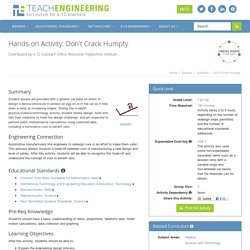
During this in-depth physics/science/technology activity, student teams design, build and test their creations to meet the design challenge, and are expected to perform basic mathematical calculations using collected data, including a summative cost to benefit ratio. Engineering Connection Automotive manufacturers hire engineers to redesign cars in an effort to make them safer.
This process always involves a trade-off between cost of manufacturing a new design and level of safety. Six Minutes of Terror - Lesson. A rover is carried through space in a spacecraft (which is separate from the actual launch vehicle, which is a rocket that propels a spacecraft into space).

The spacecraft is designed to safely carry and maneuver the rover as it enters the Martian atmosphere and lands on Mars. Two major units of spacecrafts are the cruise stage and the entry, descent, and landing system (which includes the aeroshell). In short, a launch vehicle projects a spacecraft into space, where it spends up to 6 months traveling, or cruising, the millions of miles between Earth and Mars. Forty-five days before entry into the Martian atmosphere, the cruise phase of traveling through space comes to an end, and several preparation steps are carried out to end this phase and begin the entry, descent and landing phase — also called "six minutes of terror" by NASA engineers.
At this point, the spacecraft has slowed down from 12,000 mph to a vertical stop about four or five stories above the surface. Problem Solving - Lesson. Each TeachEngineering lesson or activity is correlated to one or more K-12 science, technology, engineering or math (STEM) educational standards.
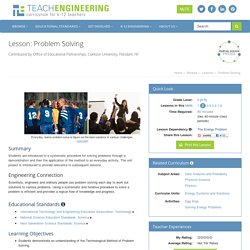
All 100,000+ K-12 STEM standards covered in TeachEngineering are collected, maintained and packaged by the Achievement Standard Network (ASN), a project of JES & Co. (www.jesandco.org). In the ASN, standards are hierarchically structured: first by source; e.g., by state; within source by type; e.g., science or mathematics; within type by subtype, then by grade, etc. Click on the standard groupings to explore this hierarchy as it applies to this document. Introduction/Motivation Scientists, engineers, and ordinary people use problem solving each day to work out solutions to various problems. In this unit, we use what is called "The Technological Method of Problem Solving. " Lesson Background and Concepts for Teachers The Seven Steps of Problem Solving 1.Identify the problem Clearly state the problem. 2.Establish what you want to achieve Research 4.
Bumps and Bruises. Summary Athletes often wear protective gear to keep themselves safe in contact sports.
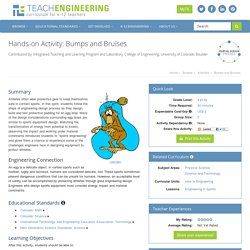
In this spirit, students follow the steps of engineering design process as they design, build and test protective padding for an egg drop. Many of the design considerations surrounding egg drops are similar to sports equipment design. Watching the transformation of energy from potential to kinetic, observing the impact and working under material constraints introduces students to "sports engineering" and gives them a chance to experience some of the challenges engineers face in designing equipment to protect athletes. Egg-cellent Landing. Summary The purpose of this activity is to recreate the classic egg-drop experiment with an analogy to the Mars rover landing.
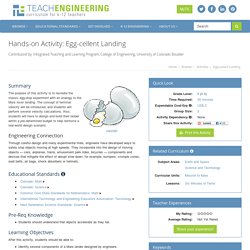
The concept of terminal velocity will be introduced, and students will perform several velocity calculations. Also, students will have to design and build their lander within a pre-determined budget to help reinforce a real-world design scenario. Engineering Connection Through careful design and many experimental trials, engineers have developed ways to safely stop objects moving at high speeds. Egg Drop. Summary A process for technical problem solving is introduced and applied to a fun demonstration.
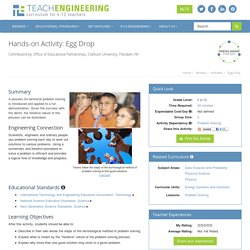
Given the success with the demo, the iterative nature of the process can be illustrated. Engineering Connection Scientists, engineers and ordinary people use problem solving each day to work out solutions to various problems. Using a systematic and iterative procedure to solve a problem is efficient and provides a logical flow of knowledge and progress. Educational Standards Each TeachEngineering lesson or activity is correlated to one or more K-12 science, technology, engineering or math (STEM) educational standards. All 100,000+ K-12 STEM standards covered in TeachEngineering are collected, maintained and packaged by the Achievement Standard Network (ASN), a project of JES & Co. In the ASN, standards are hierarchically structured: first by source; e.g., by state; within source by type; e.g., science or mathematics; within type by subtype, then by grade, etc.
Learning Objectives Materials List. Bombs Away! Summary Students design and build devices to protect and accurately deliver dropped eggs.
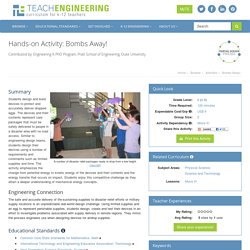
The devices and their contents represent care packages that must be safely delivered to people in a disaster area with no road access. Similar to engineering design teams, students design their devices using a number of requirements and constraints such as limited supplies and time. The activity emphasizes the change from potential energy to kinetic energy of the devices and their contents and the energy transfer that occurs on impact.
Students enjoy this competitive challenge as they attain a deeper understanding of mechanical energy concepts.